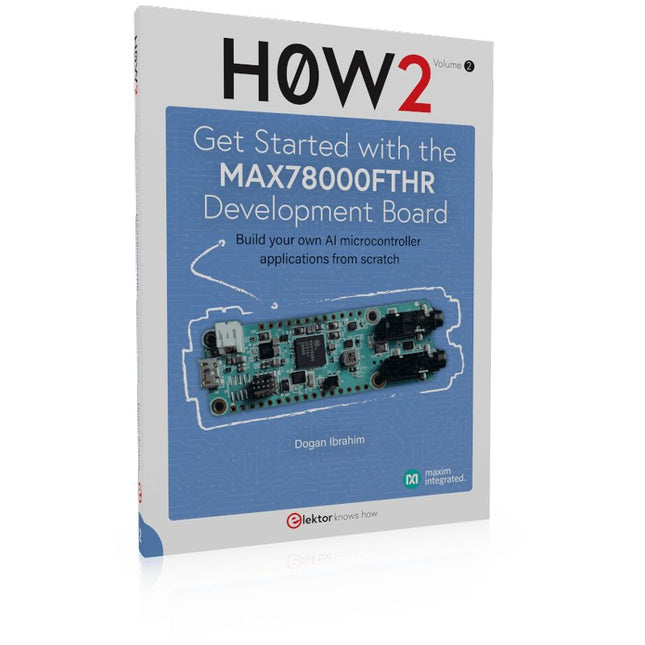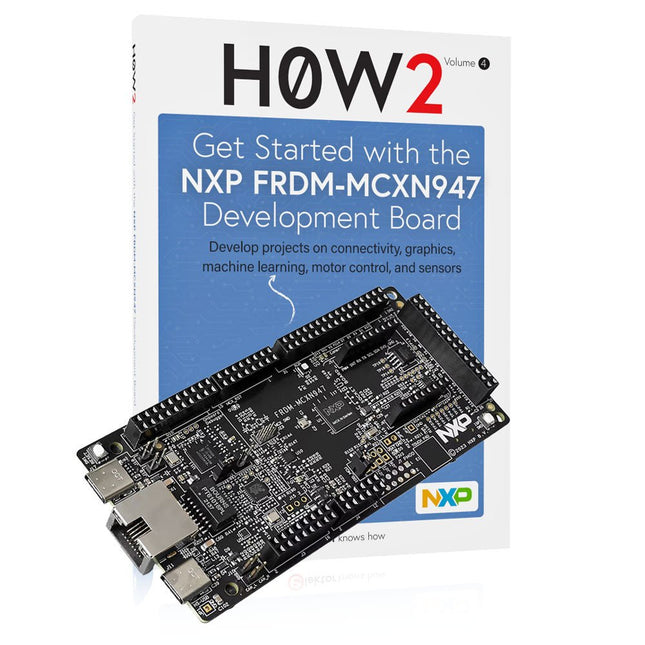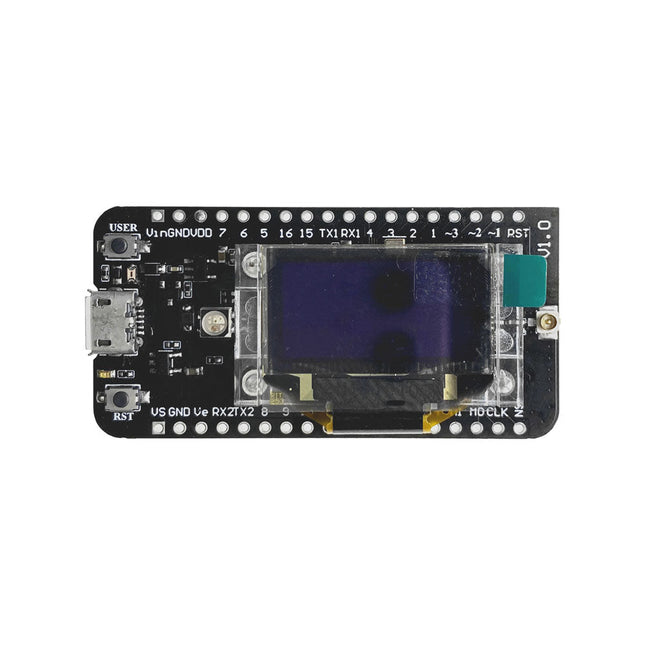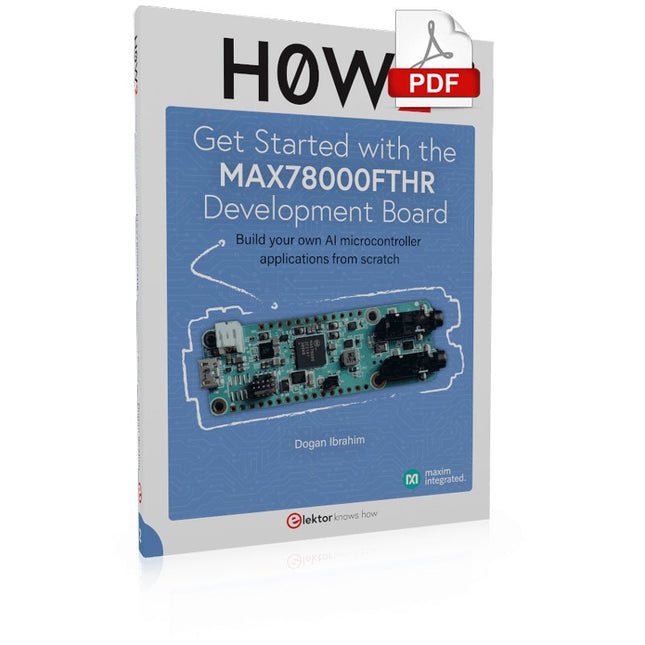Suchergebnisse für "teensy OR 4 OR 0 OR development OR board"
-

Luckfox LuckFox Pico Ultra Linux Micro Development Board
Der LuckFox Pico Ultra ist ein kompakter Single-Board-Computer (SBC) mit dem Rockchip RV1106G3-Chipsatz, der für KI-Verarbeitung, Multimedia und stromsparende Embedded-Anwendungen entwickelt wurde. Er ist mit einer integrierten 1-TOPS-NPU ausgestattet und eignet sich daher ideal für Edge-KI-Workloads. Mit 256 MB RAM, 8 GB Onboard-eMMC-Speicher, integriertem WLAN und Unterstützung für das LuckFox PoE-Modul bietet das Board Leistung und Vielseitigkeit für eine Vielzahl von Anwendungsfällen. Der LuckFox Pico Ultra läuft unter Linux und unterstützt eine Vielzahl von Schnittstellen – darunter MIPI CSI, RGB-LCD, GPIO, UART, SPI, I²C und USB – und bietet so eine einfache und effiziente Entwicklungsplattform für Anwendungen in den Bereichen Smart Home, Industriesteuerung und IoT. Technische Daten Chip Rockchip RV1106G3 Prozessor Cortex-A7 1,2 GHz Neuronaler Netzwerkprozessor (NPU) 1 TOPS, unterstützt int4, int8, int16 Bildprozessor (ISP) Max. Eingangsgeschwindigkeit 5 M @30fps Speicher 256 MB DDR3L WLAN + Bluetooth 2,4 GHz WiFi-6 Bluetooth 5.2/BLE Kameraschnittstelle MIPI CSI 2-Lane DPI-Schnittstelle RGB666 PoE-Schnittstelle IEEE 802.3af PoE Lautsprecherschnittstelle MX1,25 mm USB USB 2.0 Host/Gerät GPIO 30 GPIO Pins Ethernet 10/100M Ethernet-Controller und eingebetteter PHY Standardspeichermedium eMMC (8 GB) Lieferumfang 1x LuckFox Pico Ultra W 1x LuckFox PoE Modul 1x IPX 2,4G 2 dB Antenne 1x USB-A auf USB-C Kabel 1x Schraubensatz Downloads Wiki
€ 39,95
Mitglieder € 35,96
-

Velleman Velleman ATmega328 Uno Development Board
Das ATmega328 Uno Development Board (Arduino Uno kompatibel) ist ein Mikrocontroller-Board, das auf dem ATmega328 basiert. Es verfügt über 14 digitale Ein-/Ausgangspins (von denen 6 als PWM-Ausgänge verwendet werden können), 6 analoge Eingänge, einen 16 MHz-Keramikresonator, einen USB-Anschluss, eine Strombuchse, einen ICSP-Header und eine Reset-Taste. Es enthält alles, was zur Unterstützung des Mikrocontrollers erforderlich ist. Schließen Sie es über ein USB-Kabel an einen Computer an oder betreiben Sie es mit einem AC-DC-Adapter oder einer Batterie, um loszulegen. Technische Daten Mikrocontroller ATmega328 Betriebsspannung 5 V DC Eingangsspannung (empfohlen) 7-12 V DC Eingangsspannung (Grenzwerte) 6-20 V DC Digitale I/O-Pins 14 (davon 6 mit PWM-Ausgang) Analoge Eingangspins 6 SRAM 2 kB (ATmega328) EEPROM 1 kB (ATmega328) Flash-Speicher 32 kB (ATmega328), davon 0,5 kB vom Bootloader verwendet Taktgeschwindigkeit 16 MHz Downloads Manual
€ 22,95
Mitglieder € 20,66
-

NXP Semiconductors NXP FRDM-MCXN947 Development Board
The FRDM-MCXN947 is a compact and versatile development board designed for rapid prototyping with MCX N94 and N54 microcontrollers. It features industry-standard headers for easy access to the MCU's I/Os, integrated open-standard serial interfaces, external flash memory, and an onboard MCU-Link debugger. Technische Daten Microcontroller MCX-N947 Dual Arm Cortex-M33 cores @ 150 MHz each with optimized performance efficiency, up to 2 MB dual-bank flash with optional full ECC RAM, External flash Accelerators: Neural Processing Unit, PowerQuad, Smart DMA, etc. Memory Expansion *DNP Micro SD card socket Connectivity Ethernet Phy and connector HS USB-C connectors SPI/I²C/UART connector (PMOD/mikroBUS, DNP) WiFi connector (PMOD/mikroBUS, DNP) CAN-FD transceiver Debug On-board MCU-Link debugger with CMSIS-DAP JTAG/SWD connector Sensor P3T1755 I³C/I²C Temp Sensor, Touch Pad Expansion Options Arduino Header (with FRDM expansion rows) FRDM Header FlexIO/LCD Header SmartDMA/Camera Header Pmod *DNP mikroBUS User Interface RGB user LED, plus Reset, ISP, Wakeup buttons Lieferumfang 1x FRDM-MCXN947 Development Board 1x USB-C Cable 1x Quick Start Guide Downloads Datasheet Block diagram
€ 29,95
Mitglieder € 26,96
-

Elektor Publishing H0W2: Get Started with the MAX78000FTHR Development Board
Build your own AI microcontroller applications from scratch The MAX78000FTHR from Maxim Integrated is a small development board based on the MAX78000 MCU. The main usage of this board is in artificial intelligence applications (AI) which generally require large amounts of processing power and memory. It marries an Arm Cortex-M4 processor with a floating-point unit (FPU), convolutional neural network (CNN) accelerator, and RISC-V core into a single device. It is designed for ultra-low power consumption, making it ideal for many portable AI-based applications. This book is project-based and aims to teach the basic features of the MAX78000FTHR. It demonstrates how it can be used in various classical and AI-based projects. Each project is described in detail and complete program listings are provided. Readers should be able to use the projects as they are, or modify them to suit their applications. This book covers the following features of the MAX78000FTHR microcontroller development board: Onboard LEDs and buttons External LEDs and buttons Using analog-to-digital converters I²C projects SPI projects UART projects External interrupts and timer interrupts Using the onboard microphone Using the onboard camera Convolutional Neural Network
€ 39,95
Mitglieder € 35,96
-

Elektor Bundles Get Started with the NXP FRDM-MCXN947 Development Board (Bundle)
Dieses Bundle enthält: Buch: Get Started with the NXP FRDM-MCXN947 Development Board (Einzelpreis: 40 €) NXP FRDM-MCXN947 Development Board (Einzelpreis: 30 €) Buch: Get Started with the NXP FRDM-MCXN947 Development Board Projekte zu Konnektivität, Grafik, maschinellem Lernen, Motorsteuerung und Sensoren entwickeln Dieses (englischsprachige) Buch behandelt die Verwendung des FRDM-MCXN947 Development Boards, entwickelt von NXP Semiconductors. Es integriert den Dual Arm Cortex-M33, der mit bis zu 150 MHz arbeitet. Ideal für industrielle, IoT- und maschinelles Lernen-Anwendungen. Es verfügt über Hi-Speed USB, CAN 2.0, I³C und 10/100 Ethernet. Das Board beinhaltet einen integrierten MCU-Link-Debugger, FlexI/O zur Steuerung von LCDs und Dual-Bank-Flash für Lese-und-Schreib-Operationen, mit Unterstützung für große externe serielle Speicherkonfigurationen. Eine der wichtigen Funktionen des Entwicklungsboards ist die integrierte eIQ Neutron Neural Processing Unit (NPU), die es den Nutzern ermöglicht, AI-basierte Projekte zu entwickeln. Das Entwicklungsboard unterstützt auch Arduino Uno-Header-Pins, was es mit vielen Arduino-Shields kompatibel macht, sowie einen mikroBUS-Anschluss für MikroElektronika Click Boards und einen Pmod-Anschluss. Ein weiterer Vorteil des FRDM-MCXN947 Development Boards ist, dass es mehrere integrierte Debug-Probes enthält, die es Programmierern ermöglichen, ihre Programme direkt mit dem MCU zu debuggen. Mit Hilfe des Debuggers können Programmierer Schritt für Schritt durch ein Programm gehen, Breakpoints setzen, Variablen ansehen und ändern, und vieles mehr. Im Buch wurden viele funktionierende und getestete Projekte mit der beliebten MCUXpresso IDE und dem SDK unter Verwendung verschiedener Sensoren und Aktoren entwickelt. Auch die Verwendung der populären CMSIS-DSP-Bibliothek wird anhand mehrerer häufig genutzter Matrixoperationen erklärt. Die im Buch bereitgestellten Projekte können ohne Änderungen in vielen Anwendungen eingesetzt werden. Alternativ können die Leser ihre eigenen Projekte auf den im Buch vorgestellten Projekten aufbauen, während sie ihre eigenen Projekte entwickeln. NXP FRDM-MCXN947 Development Board TDas FRDM-MCXN947 ist ein kompaktes und vielseitiges Entwicklungsboard, das für das Rapid Prototyping mit MCX N94- und N54-Mikrocontrollern konzipiert wurde. Es verfügt über Industriestandard-Header für den einfachen Zugang zu den I/Os der MCU, integrierte serielle Schnittstellen nach offenem Standard, externen Flash-Speicher und einen Onboard-MCU-Link-Debugger. Technische Daten Mikrocontroller MCX-N947 Dual Arm Cortex-M33-Kerne mit jeweils 150 MHz und optimierter Leistungseffizienz, bis zu 2 MB Dual-Bank-Flash mit optionalem Full-ECC-RAM, externer Flash Beschleuniger: Neural Processing Unit, PowerQuad, Smart DMA usw. Speichererweiterung *DNP MicroSD-Kartensteckplatz Konnektivität Ethernet Phy und Connector HS USB-C-Anschlüsse SPI/I²C/UART-Anschluss (PMOD/mikroBUS, DNP) WiFi-Anschluss (PMOD/mikroBUS, DNP) CAN-FD-Transceiver Debuggen Integrierter MCU-Link-Debugger mit CMSIS-DAP JTAG/SWD-Anschluss Sensor P3T1755 I³C/I²C-Temperatursensor, Touchpad Erweiterungsoptionen Arduino-Header (mit FRDM-Erweiterungszeilen) FRDM-Header FlexIO/LCD-Header SmartDMA/Kamera-Header Pmod *DNP mikroBUS Benutzeroberfläche RGB-Benutzer-LED sowie Reset-, ISP- und Wakeup-Tasten Lieferumfang 1x FRDM-MCXN947 Development Board 1x USB-C Kabel 1x Quick Start Guide Downloads Datasheet Block diagram
€ 69,95€ 29,95
Mitglieder identisch
-

Farnell element14 OKdo E1 Entwicklungsboard
Das OKdo E1 ist ein äußerst kostengünstiges Entwicklungsboard, das auf dem Dual-Core-Arm-Cortex-M33-Mikrocontroller LPC55S69JBD100 von NXP basiert. Das E1-Board eignet sich perfekt für industrielles IoT, Gebäudesteuerung und -automatisierung, Unterhaltungselektronik sowie allgemeine eingebettete und sichere Anwendungen. Merkmale Prozessor mit Arm TrustZone, Floating Point Unit (FPU) und Memory Protection Unit (MPU) CASPER Crypto-Coprozessor zur Hardwarebeschleunigung für bestimmte asymmetrische kryptografische Algorithmen PowerQuad Hardware Accelerator für Fest- und Gleitkomma-DSP-Funktionen SRAM Physical Unclonable Function (PUF) zur Schlüsselgenerierung, -speicherung und -rekonstruktion PRINCE-Modul zur Echtzeit-Verschlüsselung und Entschlüsselung von Flash-Daten AES-256- und SHA2-Engines Bis zu neun Flexcomm-Schnittstellen. Jede Flexcomm-Schnittstelle kann per Software als USART-, SPI-, I²C- und I²S-Schnittstelle ausgewählt werden USB 2.0 High-Speed-Host/Geräte-Controller mit On-Chip-PHY USB 2.0 Full-Speed Host/Geräte-Controller mit On-Chip-PHY Bis zu 64 GPIOs Sichere digitale Ein-/Ausgabe-Kartenschnittstelle (SD/MMC und SDIO). Spezifikationen LPC55S69JBD100 640-KByte-Flash-Mikrocontroller Eingebauter CMSIS-DAP v1.0.7-Debugger basierend auf LPC11U35 Interne PLL-Unterstützung für einen Betrieb mit bis zu 100 MHz, 16 MHz können für den vollen 150-MHz-Betrieb montiert werden. SRAM 320kB 32-kHz-Quarz für Echtzeituhr 4 Benutzerschalter 3-Farben-LED Benutzer-USB-Anschluss 2 16-polige Erweiterungsstecker UART über USB virtueller COM-Port
€ 24,95
Mitglieder € 22,46
-

Waveshare QuecPython EC200U-EU C4-P01 Development Board
The EC200U-EU C4-P01 development board features the EC200U-EU LTE Cat 1 wireless communication module, offering a maximum data rate of up to 10 Mbps for downlink and 5 Mbps for uplink. It supports multi-mode and multi-band communication, making it a cost-effective solution. The board is designed in a compact and unified form factor, compatible with the Quectel multi-mode LTE Standard EC20-CE. It includes an onboard USB-C port, allowing for easy development with just a USB-C cable. Additionally, the board is equipped with a 40-pin GPIO header that is compatible with most Raspberry Pi HATs. Features Equipped with EC200U-EU LTE Cat 1 wireless communication module, multi-mode & multi-band support Onboard 40-Pin GPIO header, compatible with most Raspberry Pi HATs 5 LEDs for indicating module operating status Supports TCP, UDP, PPP, NITZ, PING, FILE, MQTT, NTP, HTTP, HTTPS, SSL, FTP, FTPS, CMUX, MMS protocols, etc. Supports GNSS positioning (GPS, GLONASS, BDS, Galileo, QZSS) Onboard Nano SIM card slot and eSIM card slot, dual card single standby Onboard MIPI connector for connecting MIPI screen and is fully compatible with Raspberry Pi peripherals Onboard camera connector, supports customized SPI cameras with a maximum of 300,000 pixels Provides tools such as QPYcom, Thonny IDE plugin, and VSCode plugin, etc. for easy learning and development Comes with online development resources and manual (example in QuecPython) Technische Daten Applicable Regions Europe, Middle East, Africa, Australia, New Zealand, Brazil LTE-FDD B1, B3, B5, B7, B8, B20, B28 LTE-TDD B38, B40, B41 GSM / GPRS / EDGE GSM: B2, B3, B5, B8 GNSS GPS, GLONASS, BDS, Galileo, QZSS Bluetooth Bluetooth 4.2 (BR/EDR) Wi-Fi Scan 2.4 GHz 11b (Rx) CAT 1 LTE-FDD: DL 10 Mbps; UL 5 Mbps LTE-TDD: DL 8.96 Mbps; UL 3.1 Mbps GSM / GPRS / EDGE GSM: DL 85.6 Kbps; UL 85.6 Kbps USB-C Port Supports AT commands testing, GNSS positioning, firmware upgrading, etc. Communication Protocol TCP, UDP, PPP, NITZ, PING, FILE, MQTT, NTP, HTTP, HTTPS, SSL, FTP, FTPS, CMUX, MMS SIM Card Nano SIM and eSIM, dual card single standby Indicator P01: Module Pin 1, default as EC200A-XX PWM0 P05: Module Pin 5, NET_MODE indicator SCK1: SIM1 detection indicator, lights up when SIM1 card is inserted SCK2: SIM2 detection indicator, lights up when SIM2 card is inserted PWR: Power indicator Buttons PWK: Power ON/OFF RST: Reset BOOT: Forcing into firmware burning mode USB ON/OFF: USB power consumption detection switch Antenna Connectors LTE main antenna + DIV / WiFi (scanning only) / Bluetooth antenna + GNSS antenna Operating Temperature −30~+75°C Storage Temperature −45~+90°C Downloads Wiki Quectel Resources
€ 69,95€ 49,95
Mitglieder identisch
-

Heltec Automation CubeCell HTCC-AB02S LoRa Development Board with GPS (EU868)
The CubeCell series is designed primarily for LoRa/LoRaWAN node applications. Built on the ASR605x platform (ASR6501, ASR6502), these chips integrate the PSoC 4000 series MCU (ARM Cortex-M0+ Core) with the SX1262 module. The CubeCell series offers seamless Arduino compatibility, stable LoRaWAN protocol operation, and straightforward connectivity with lithium batteries and solar panels. The HTCC-AB02S is a developer-friendly board with an integrated AIR530Z GPS module, ideal for quickly testing and validating communication solutions. Features Arduino compatible Based on ASR605x (ASR6501, ASR6502), those chips are already integrated the PSoC 4000 series MCU (ARM Cortex M0+ Core) and SX1262 LoRaWAN 1.0.2 support Ultra low power design, 21 uA in deep sleep Onboard SH1.25-2 battery interface, integrated lithium battery management system (charge and discharge management, overcharge protection, battery power detection, USB/battery power automatic switching) Good impendence matching and long communication distance Onboard solar energy management system, can directly connect with a 5.5~7 V solar panel Micro USB interface with complete ESD protection, short circuit protection, RF shielding, and other protection measures Integrated CP2102 USB to serial port chip, convenient for program downloading, debugging information printing Onboard 0.96-inch 128x64 dot matrix OLED display, which can be used to display debugging information, battery power, and other information Using Air530 GPS module with GPS/Beidou Dual-mode position system support Specifications Main Chip ASR6502 (48 MHz ARM Cortex-M0+ MCU) LoRa Chipset SX1262 Frequency 863~870 MHz Max. TX Power 22 ±1 dBm Max. Receiving Sensitivity −135 dBm Hardware Resource 2x UART1x SPI2x I²C1x SWD3x 12-bit ADC input8-channel DMA engine16x GPIO Memory 128 Kb FLASH16 Kb SRAM Power consumption Deep sleep 21 uA Interfaces 1x Micro USB1x LoRa Antenna (IPEX)2x (15x 2.54 Pin header) + 3x (2x 2.54 Pin header) Battery 3.7 V lithium battery (power supply and charging) Solar Energy VS pin can be connected to 5.5~7 V solar panel USB to Serial Chip CP2102 Display 0.96" OLED (128 x 64) Operating temperature −20~70°C Dimensions 55.9 x 27.9 x 9.5 mm Included 1x CubeCell HTCC-AB02S Development Board 1x Antenna 1x 2x SH1.25 battery connector Downloads Datasheet Schematic GPS module (Manual) Quick start GitHub
€ 49,95€ 34,95
Mitglieder identisch
-

Waveshare Waveshare RP2040-PiZero Entwicklungsboard
Waveshare RP2040-PiZero ist eine leistungsstarke und kostengünstige Mikrocontrollerkarte mit integrierter DVI-Schnittstelle, TF-Kartensteckplatz und PIO-USB-Anschluss, kompatibel mit dem 40-poligen GPIO-Header von Raspberry Pi, einfach zu entwickeln und in die Produkte zu integrieren. Merkmale RP2040-Mikrocontrollerchip, entwickelt von Raspberry Pi Dual-Core ARM Cortex M0+ Prozessor, flexible Taktung bis zu 133 MHz 264 KB SRAM und 16 MB integrierter Flash-Speicher Die integrierte DVI-Schnittstelle kann die meisten HDMI-Bildschirme ansteuern (DVI-Kompatibilität erforderlich) Unterstützt die Verwendung als USB-Host oder -Slave über den integrierten PIO-USB-Anschluss Integrierter TF-Kartensteckplatz zum Lesen und Schreiben der TF-Karte Integrierter Anschluss zum Aufladen/Entladen der Lithiumbatterie, geeignet für mobile Szenarien USB 1.1 mit Geräte- und Host-Unterstützung Drag-and-Drop-Programmierung mit Massenspeicher über USB Energiesparender Ruhe- und Ruhemodus 2x SPI, 2x I²C, 2x UART, 4x 12-Bit-ADC, 16x steuerbare PWM-Kanäle Präzise Uhr und Timer auf dem Chip Temperatursensor Beschleunigte Gleitkommabibliotheken auf dem Chip Downloads Wiki
€ 17,95
Mitglieder € 16,16
-

Ohmic PUCA DSP ESP32 Entwicklungsboard
PÚCA DSP ist ein Arduino-kompatibles Open-Source-ESP32-Entwicklungsboard für Audio- und digitale Signalverarbeitungsanwendungen (DSP) mit umfangreichen Audioverarbeitungsfunktionen. Es bietet Audioeingänge, -ausgänge, ein rauscharmes Mikrofonarray, eine integrierte Testlautsprecheroption, zusätzlichen Speicher, Batterielademanagement und ESD-Schutz – alles auf einer kleinen, Breadboard-freundlichen Platine. Synthesizer, Installationen, Voice UI und mehr PÚCA DSP kann für eine breite Palette von DSP-Anwendungen eingesetzt werden, unter anderem in den Bereichen Musik, Kunst, Kreativtechnik und adaptive Technologie. Beispiele aus dem Musikbereich sind digitale Musiksynthese, mobile Aufnahmen, Bluetooth-Lautsprecher, drahtlose Richtmikrofone und die Entwicklung intelligenter Musikinstrumente. Beispiele aus dem Bereich Kunst sind akustische Sensornetzwerke, Klangkunstinstallationen und Internet-Radioanwendungen. Beispiele aus dem Bereich der kreativen und adaptiven Technologie sind das Design von Sprachbenutzerschnittstellen (VUI) und Web-Audio für das Internet der Klänge. Kompaktes, integriertes Design PÚCA DSP wurde für den mobilen Einsatz konzipiert. In Verbindung mit einem externen 3,7-V-Akku kann er fast überall eingesetzt oder in nahezu jedes Gerät, Instrument oder jede Installation integriert werden. Sein Design entstand aus monatelangen Experimenten mit verschiedenen ESP32-Entwicklungsboards, DAC-Breakout-Boards, ADC-Breakout-Boards, Mikrofon-Breakout-Boards und Audio-Anschluss-Breakout-Boards, und – trotz seiner geringen Größe – schafft er es, all diese Funktionen in einem einzigen Board zu vereinen. Und das ohne Kompromisse bei der Signalqualität. Technische Daten Prozessor und Speicher Espressif ESP32 Pico D4 Prozessor 32-bit Dual-Core 80 MHz/160 MHz/240 MHz 4 MB SPI Flash mit 8 MB zusätzlichem PSRAM (Original Edition) Drahtloses 2,4-GHz-WLAN 802.11b/g/n Bluetooth BLE 4.2 3D-Antenne Audio Wolfson WM8978 Stereo-Audio-Codec Audio-Line-In am 3,5-mm-Stereoanschluss Audio-Kopfhörer-/Line-Ausgang am 3,5-mm-Stereoanschluss Stereo-Aux-Line-In, Audio-Mono-Out zum GPIO-Header geleitet 2x Knowles SPM0687LR5H-1 MEMS-Mikrofone ESD-Schutz an allen Audioeingängen und -ausgängen Unterstützung für Abtastraten von 8, 11,025, 12, 16, 22,05, 24, 32, 44,1 und 48 kHz 1-W-Lautsprechertreiber, auf GPIO-Header geroutet DAC SNR 98 dB, THD -84 dB ('A'-gewichtet bei 48 kHz) ADC SNR 95 dB, THD -84 dB (‘A’-gewichtet bei 48 kHz) Line-Eingangsimpedanz: 1 MOhm Line-Ausgangsimpedanz: 33 Ohm Formfaktor und Konnektivität Breadboard-freundlich 70 x 24 mm 11x GPIO-Pins mit 2,54 mm Rastermaß, mit Zugriff auf beide ESP32-ADC-Kanäle, JTAG und kapazitive Touch-Pins USB 2.0 über USB-Typ-C-Anschluss Stromversorgung 3,7/4,2 V Lithium-Polymer-Akku, USB oder externe 5 V DC-Stromquelle ESP32 und Audio-Codec können softwaregesteuert in Energiesparmodi versetzt werden Erkennung des Batteriespannungspegels ESD-Schutz am USB-Datenbus Downloads GitHub Datasheet Links Crowd Supply Campaign (includes FAQs) Hardware Overview Programming the Board The Audio Codec
€ 69,95€ 49,95
Mitglieder identisch
-

01Space 01Space RP2040-0.42LCD Entwicklungsboard
Arduino-, MicroPython- und CircuitPython-kompatibles, kompaktes Entwicklungsboard mit Raspberry Pi RP2040 RP2040-0.42LCD ist ein leistungsstarkes Entwicklungsboard mit integriertem 0.42" LCD (70x40 Auflösung) mit flexiblen digitalen Schnittstellen. Es enthält den RP2040 Mikrocontroller-Chip des Raspberry Pi. Der RP2040 verfügt über einen Dual-Core Arm Cortex-M0+ Prozessor, der mit 133 MHz getaktet ist, mit 264 KB internem SRAM und 2 MB Flash-Speicher. Technische Spezifikationen SoC Raspberry Pi RP2040 Dual-Core Cortex-M0+ Mikrocontroller mit bis zu 125 MHz, mit 264 KB SRAM Speicher 2 MB SPI-Flash Display 0,42-Zoll-OLED USB 1x USB Typ-C Anschluss für Stromversorgung und Programmierung Expansion - Qwiic I²C-Anschluss- 7-polige und 8-polige Stiftleisten mit bis zu 11x GPIOs, 2x SPI, 2x I²C, 4x ADC, 1x UART, 5 V, 3,3 V, VBAT, GND Misc - Reset- und Boot-Tasten- RGB-LED, Betriebs-LED Stromversorgung - 5 V über USB-C-Anschluss oder Vin- VBAT-Pin für Batterieeingang- 3,3-V-Regler mit 500-mA-Spitzenleistung Dimensionen 23.5 x 18 mm Gewicht 2.5 g Downloads GitHub
€ 19,95
Mitglieder € 17,96
-

Elektor Digital H0W2: Get Started with the MAX78000FTHR Development Board (E-book)
Build your own AI microcontroller applications from scratch The MAX78000FTHR from Maxim Integrated is a small development board based on the MAX78000 MCU. The main usage of this board is in artificial intelligence applications (AI) which generally require large amounts of processing power and memory. It marries an Arm Cortex-M4 processor with a floating-point unit (FPU), convolutional neural network (CNN) accelerator, and RISC-V core into a single device. It is designed for ultra-low power consumption, making it ideal for many portable AI-based applications. This book is project-based and aims to teach the basic features of the MAX78000FTHR. It demonstrates how it can be used in various classical and AI-based projects. Each project is described in detail and complete program listings are provided. Readers should be able to use the projects as they are, or modify them to suit their applications. This book covers the following features of the MAX78000FTHR microcontroller development board: Onboard LEDs and buttons External LEDs and buttons Using analog-to-digital converters I²C projects SPI projects UART projects External interrupts and timer interrupts Using the onboard microphone Using the onboard camera Convolutional Neural Network
€ 32,95
Mitglieder € 26,36











